Annual migration of herds of sheep across world's highest lakes
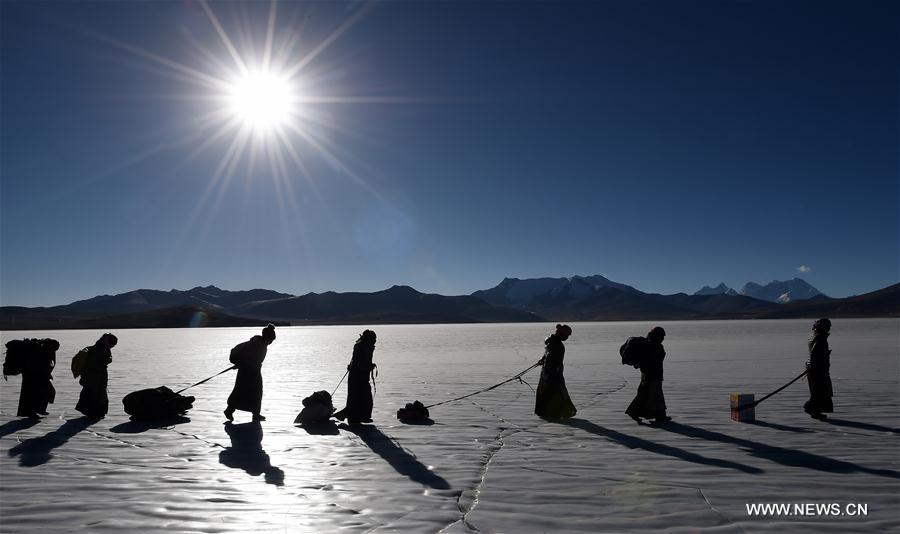
Villagers walk on the frozen Puma Yumco Lake to send supplies to herders on the islands in Dowa village in Nakartse county, southwest China's Tibet Autonomous Region, Feb. 9, 2017. It is the coldest point of the year in Tibet, and time for the annual migration of herds of sheep across an icy lake, a dangerous and exhilarating ancient practice. At Dowa village, 5,070 meters above sea level, thousands of sheep were taken across frozen water to two islands on Puma Yumco Lake, one of the world's highest lakes. The migration started before dawn. Hundreds of sheep move forward, one after another, and the icy surface squeaks under the enormous weight of the animals. When smaller animals wander off and fall, the herders take them back by carrying them in their arms. It takes more than two hours to complete the three-kilometer journey across the frozen lake. Herders will spend a month with the animals on the islands, where grass grows to waist height. [Xinhua/Chogo]
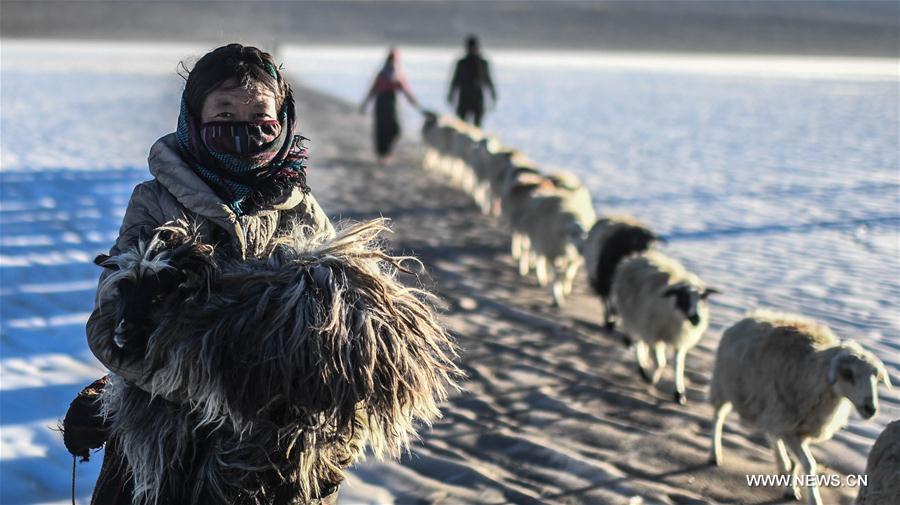
A villager carries a lamb and walks on the frozen Puma Yumco Lake, southwest China's Tibet Autonomous Region, Feb. 9, 2017. It is the coldest point of the year in Tibet, and time for the annual migration of herds of sheep across an icy lake, a dangerous and exhilarating ancient practice. At Dowa village, 5,070 meters above sea level, thousands of sheep were taken across frozen water to two islands on Puma Yumco Lake, one of the world's highest lakes. The migration started before dawn. Hundreds of sheep move forward, one after another, and the icy surface squeaks under the enormous weight of the animals. When smaller animals wander off and fall, the herders take them back by carrying them in their arms. It takes more than two hours to complete the three-kilometer journey across the frozen lake. Herders will spend a month with the animals on the islands, where grass grows to waist height. [Xinhua/Purbu Zhaxi]
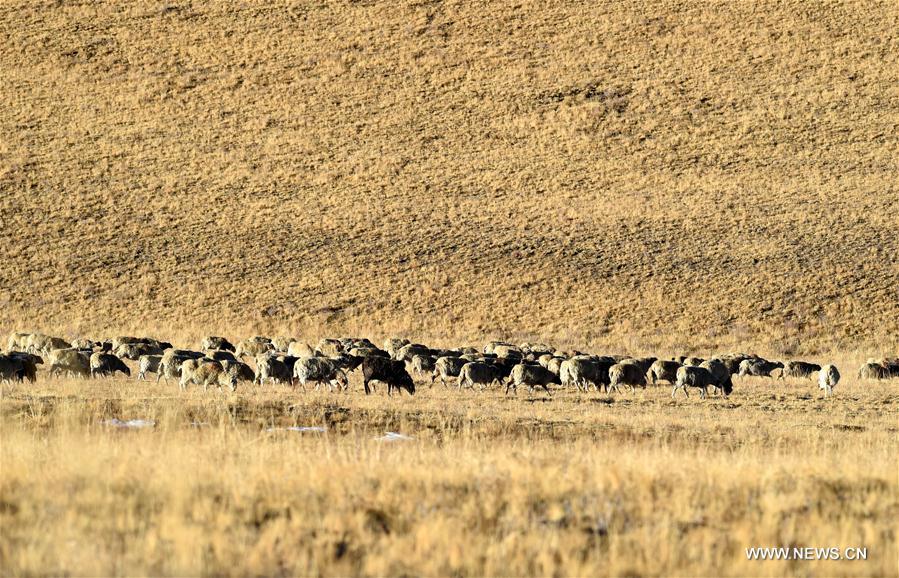
A herd of sheep graze on an island on Puma Yumco Lake, southwest China's Tibet Autonomous Region, Feb. 9, 2017. It is the coldest point of the year in Tibet, and time for the annual migration of herds of sheep across an icy lake, a dangerous and exhilarating ancient practice. At Dowa village, 5,070 meters above sea level, thousands of sheep were taken across frozen water to two islands on Puma Yumco Lake, one of the world's highest lakes. The migration started before dawn. Hundreds of sheep move forward, one after another, and the icy surface squeaks under the enormous weight of the animals. When smaller animals wander off and fall, the herders take them back by carrying them in their arms. It takes more than two hours to complete the three-kilometer journey across the frozen lake. Herders will spend a month with the animals on the islands, where grass grows to waist height. [Xinhua/Chogo]
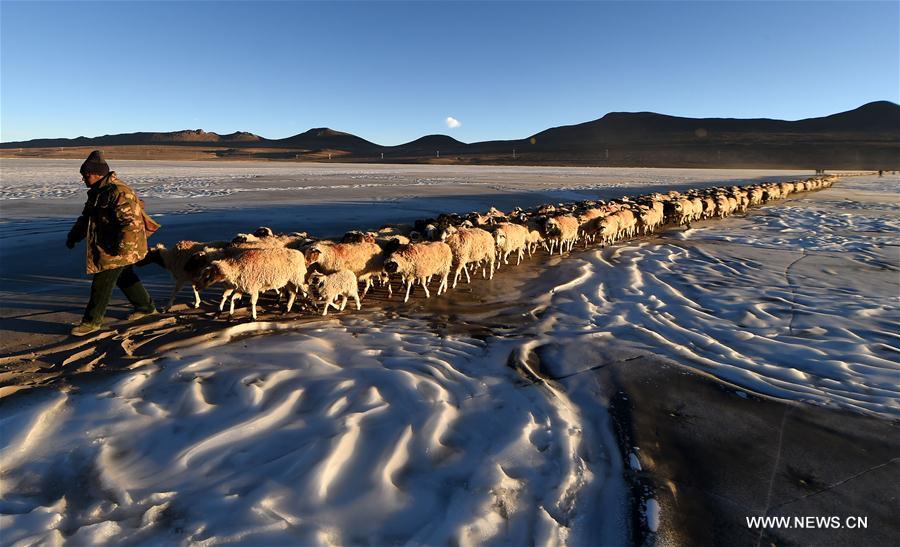
A villager leads a herd of sheep on the frozen Puma Yumco Lake, southwest China's Tibet Autonomous Region, Feb. 9, 2017. It is the coldest point of the year in Tibet, and time for the annual migration of herds of sheep across an icy lake, a dangerous and exhilarating ancient practice. At Dowa village, 5,070 meters above sea level, thousands of sheep were taken across frozen water to two islands on Puma Yumco Lake, one of the world's highest lakes. The migration started before dawn. Hundreds of sheep move forward, one after another, and the icy surface squeaks under the enormous weight of the animals. When smaller animals wander off and fall, the herders take them back by carrying them in their arms. It takes more than two hours to complete the three-kilometer journey across the frozen lake. Herders will spend a month with the animals on the islands, where grass grows to waist height. [Xinhua/Chogo]
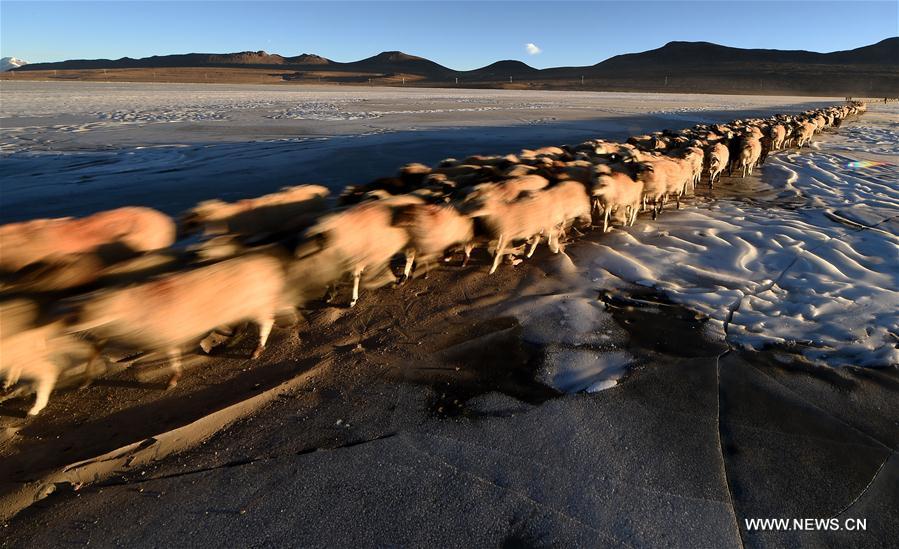
A herd of sheep move on the frozen Puma Yumco Lake, southwest China's Tibet Autonomous Region, Feb. 9, 2017. It is the coldest point of the year in Tibet, and time for the annual migration of herds of sheep across an icy lake, a dangerous and exhilarating ancient practice. At Dowa village, 5,070 meters above sea level, thousands of sheep were taken across frozen water to two islands on Puma Yumco Lake, one of the world's highest lakes. The migration started before dawn. Hundreds of sheep move forward, one after another, and the icy surface squeaks under the enormous weight of the animals. When smaller animals wander off and fall, the herders take them back by carrying them in their arms. It takes more than two hours to complete the three-kilometer journey across the frozen lake. Herders will spend a month with the animals on the islands, where grass grows to waist height. [Xinhua/Chogo]
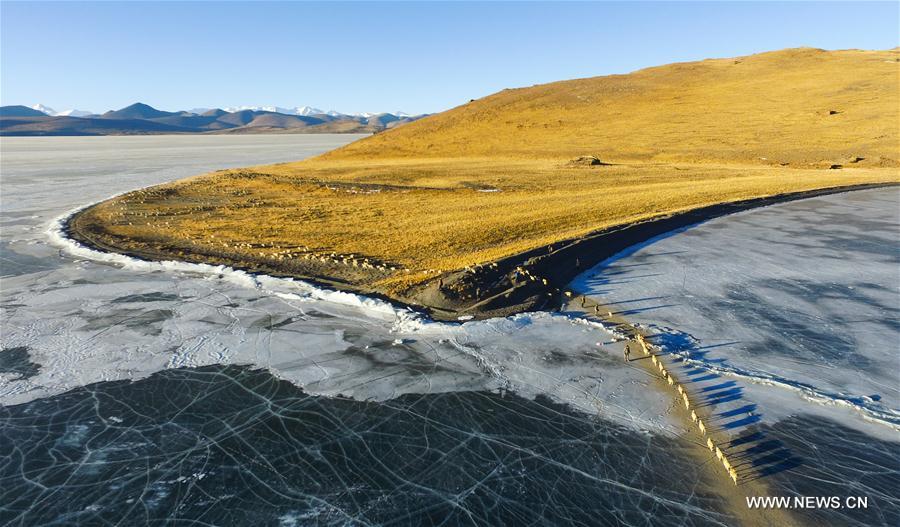
A herd of sheep move to an island on the frozen Puma Yumco Lake, southwest China's Tibet Autonomous Region, Feb. 9, 2017. It is the coldest point of the year in Tibet, and time for the annual migration of herds of sheep across an icy lake, a dangerous and exhilarating ancient practice. At Dowa village, 5,070 meters above sea level, thousands of sheep were taken across frozen water to two islands on Puma Yumco Lake, one of the world's highest lakes. The migration started before dawn. Hundreds of sheep move forward, one after another, and the icy surface squeaks under the enormous weight of the animals. When smaller animals wander off and fall, the herders take them back by carrying them in their arms. It takes more than two hours to complete the three-kilometer journey across the frozen lake. Herders will spend a month with the animals on the islands, where grass grows to waist height. [Xinhua/Purbu Zhaxi]
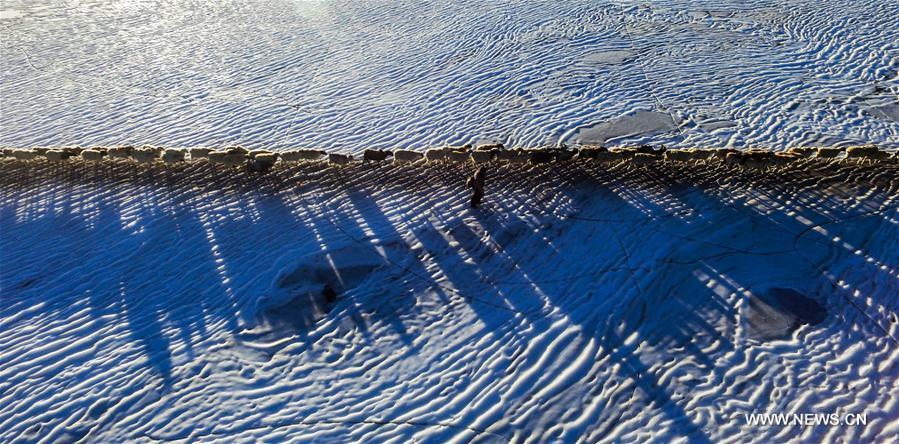
A villager leads a herd of sheep on the frozen Puma Yumco Lake, southwest China's Tibet Autonomous Region, Feb. 9, 2017. It is the coldest point of the year in Tibet, and time for the annual migration of herds of sheep across an icy lake, a dangerous and exhilarating ancient practice. At Dowa village, 5,070 meters above sea level, thousands of sheep were taken across frozen water to two islands on Puma Yumco Lake, one of the world's highest lakes. The migration started before dawn. Hundreds of sheep move forward, one after another, and the icy surface squeaks under the enormous weight of the animals. When smaller animals wander off and fall, the herders take them back by carrying them in their arms. It takes more than two hours to complete the three-kilometer journey across the frozen lake. Herders will spend a month with the animals on the islands, where grass grows to waist height. [Xinhua/Purbu Zhaxi]

A herd of sheep move to an island on the frozen Puma Yumco Lake, southwest China's Tibet Autonomous Region, Feb. 9, 2017. It is the coldest point of the year in Tibet, and time for the annual migration of herds of sheep across an icy lake, a dangerous and exhilarating ancient practice. At Dowa village, 5,070 meters above sea level, thousands of sheep were taken across frozen water to two islands on Puma Yumco Lake, one of the world's highest lakes. The migration started before dawn. Hundreds of sheep move forward, one after another, and the icy surface squeaks under the enormous weight of the animals. When smaller animals wander off and fall, the herders take them back by carrying them in their arms. It takes more than two hours to complete the three-kilometer journey across the frozen lake. Herders will spend a month with the animals on the islands, where grass grows to waist height. [Xinhua/Purbu Zhaxi]

The Dowa village in Nakartse county is seen beside the frozen Puma Yumco Lake, southwest China's Tibet Autonomous Region, Feb. 9, 2017. It is the coldest point of the year in Tibet, and time for the annual migration of herds of sheep across an icy lake, a dangerous and exhilarating ancient practice. At Dowa village, 5,070 meters above sea level, thousands of sheep were taken across frozen water to two islands on Puma Yumco Lake, one of the world's highest lakes. The migration started before dawn. Hundreds of sheep move forward, one after another, and the icy surface squeaks under the enormous weight of the animals. When smaller animals wander off and fall, the herders take them back by carrying them in their arms. It takes more than two hours to complete the three-kilometer journey across the frozen lake. Herders will spend a month with the animals on the islands, where grass grows to waist height. [Xinhua/Purbu Zhaxi]
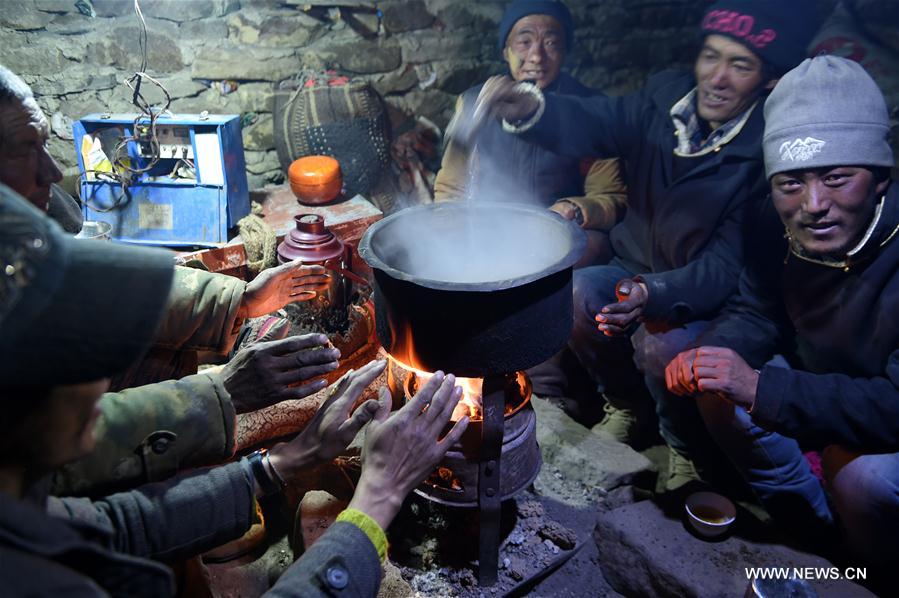
Herders warm themselves near a stove near the frozen Puma Yumco Lake, southwest China's Tibet Autonomous Region, Feb. 8, 2017. It is the coldest point of the year in Tibet, and time for the annual migration of herds of sheep across an icy lake, a dangerous and exhilarating ancient practice. At Dowa village, 5,070 meters above sea level, thousands of sheep were taken across frozen water to two islands on Puma Yumco Lake, one of the world's highest lakes. The migration started before dawn. Hundreds of sheep move forward, one after another, and the icy surface squeaks under the enormous weight of the animals. When smaller animals wander off and fall, the herders take them back by carrying them in their arms. It takes more than two hours to complete the three-kilometer journey across the frozen lake. Herders will spend a month with the animals on the islands, where grass grows to waist height. [Xinhua/Chogo]

Villagers and a herd of sheep move towards an island on the frozen Puma Yumco Lake, southwest China's Tibet Autonomous Region, Feb. 9, 2017. It is the coldest point of the year in Tibet, and time for the annual migration of herds of sheep across an icy lake, a dangerous and exhilarating ancient practice. At Dowa village, 5,070 meters above sea level, thousands of sheep were taken across frozen water to two islands on Puma Yumco Lake, one of the world's highest lakes. The migration started before dawn. Hundreds of sheep move forward, one after another, and the icy surface squeaks under the enormous weight of the animals. When smaller animals wander off and fall, the herders take them back by carrying them in their arms. It takes more than two hours to complete the three-kilometer journey across the frozen lake. Herders will spend a month with the animals on the islands, where grass grows to waist height. [Xinhua/Purbu Zhaxi]

Villagers lead a herd of sheep on the frozen Puma Yumco Lake, southwest China's Tibet Autonomous Region, Feb. 9, 2017. It is the coldest point of the year in Tibet, and time for the annual migration of herds of sheep across an icy lake, a dangerous and exhilarating ancient practice. At Dowa village, 5,070 meters above sea level, thousands of sheep were taken across frozen water to two islands on Puma Yumco Lake, one of the world's highest lakes. The migration started before dawn. Hundreds of sheep move forward, one after another, and the icy surface squeaks under the enormous weight of the animals. When smaller animals wander off and fall, the herders take them back by carrying them in their arms. It takes more than two hours to complete the three-kilometer journey across the frozen lake. Herders will spend a month with the animals on the islands, where grass grows to waist height. [Xinhua/Purbu Zhaxi]
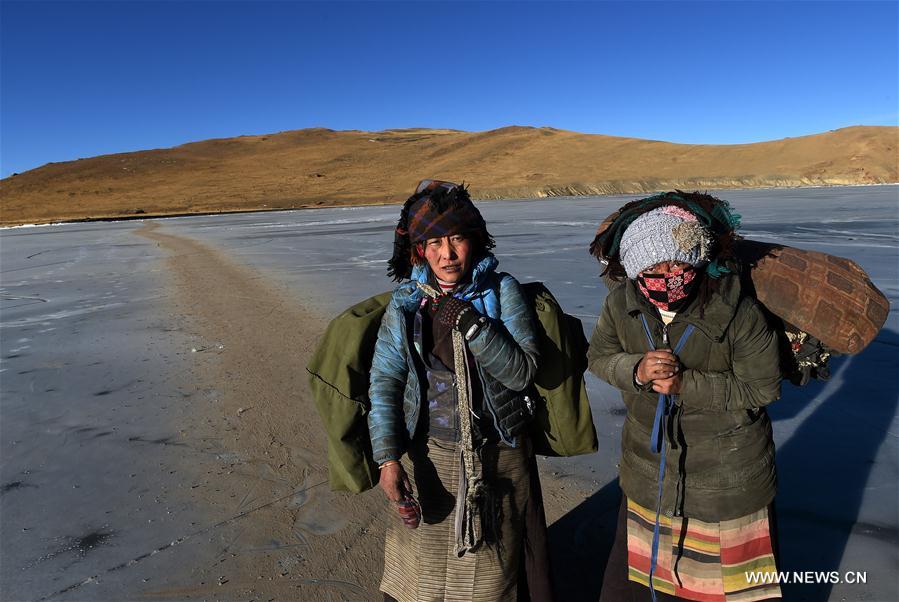
Villagers place the cow dung to prevent sheep from skidding on the frozen Puma Yumco Lake, southwest China's Tibet Autonomous Region, Feb. 9, 2017. It is the coldest point of the year in Tibet, and time for the annual migration of herds of sheep across an icy lake, a dangerous and exhilarating ancient practice. At Dowa village, 5,070 meters above sea level, thousands of sheep were taken across frozen water to two islands on Puma Yumco Lake, one of the world's highest lakes. The migration started before dawn. Hundreds of sheep move forward, one after another, and the icy surface squeaks under the enormous weight of the animals. When smaller animals wander off and fall, the herders take them back by carrying them in their arms. It takes more than two hours to complete the three-kilometer journey across the frozen lake. Herders will spend a month with the animals on the islands, where grass grows to waist height. [Xinhua/Chogo]
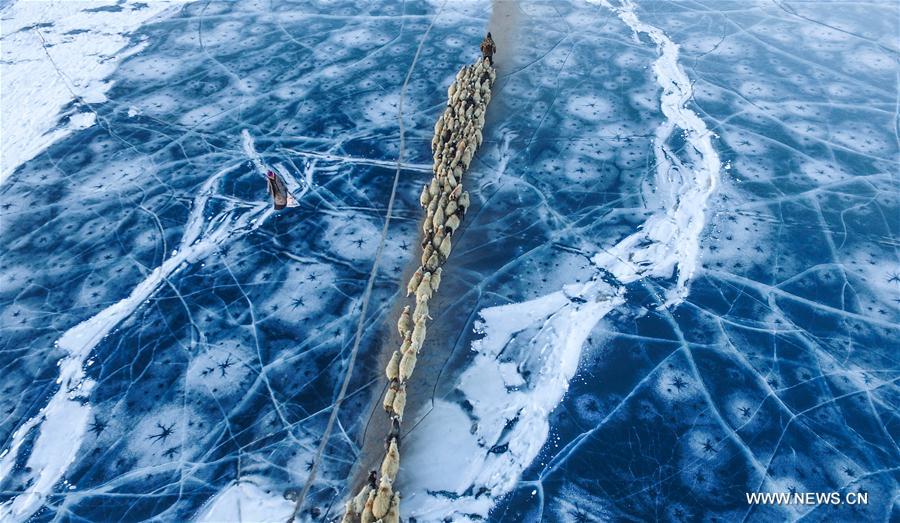
A villager leads a herd of sheep on the frozen Puma Yumco Lake, southwest China's Tibet Autonomous Region, Feb. 9, 2017. It is the coldest point of the year in Tibet, and time for the annual migration of herds of sheep across an icy lake, a dangerous and exhilarating ancient practice. At Dowa village, 5,070 meters above sea level, thousands of sheep were taken across frozen water to two islands on Puma Yumco Lake, one of the world's highest lakes. The migration started before dawn. Hundreds of sheep move forward, one after another, and the icy surface squeaks under the enormous weight of the animals. When smaller animals wander off and fall, the herders take them back by carrying them in their arms. It takes more than two hours to complete the three-kilometer journey across the frozen lake. Herders will spend a month with the animals on the islands, where grass grows to waist height. [Xinhua/Purbu Zhaxi]
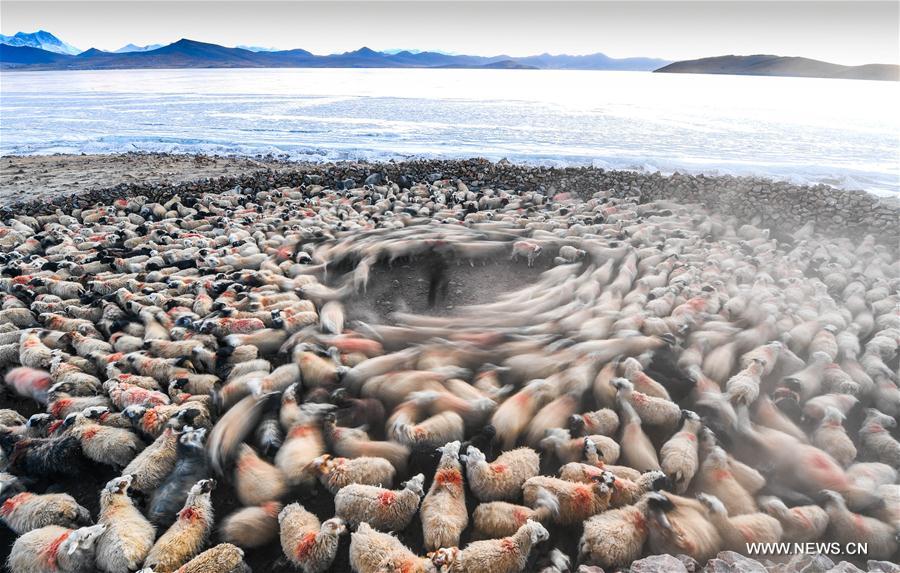
A villager counts sheep before stepping onto the frozen Puma Yumco Lake, southwest China's Tibet Autonomous Region, Feb. 8, 2017. It is the coldest point of the year in Tibet, and time for the annual migration of herds of sheep across an icy lake, a dangerous and exhilarating ancient practice. At Dowa village, 5,070 meters above sea level, thousands of sheep were taken across frozen water to two islands on Puma Yumco Lake, one of the world's highest lakes. The migration started before dawn. Hundreds of sheep move forward, one after another, and the icy surface squeaks under the enormous weight of the animals. When smaller animals wander off and fall, the herders take them back by carrying them in their arms. It takes more than two hours to complete the three-kilometer journey across the frozen lake. Herders will spend a month with the animals on the islands, where grass grows to waist height. [Xinhua/Purbu Zhaxi]
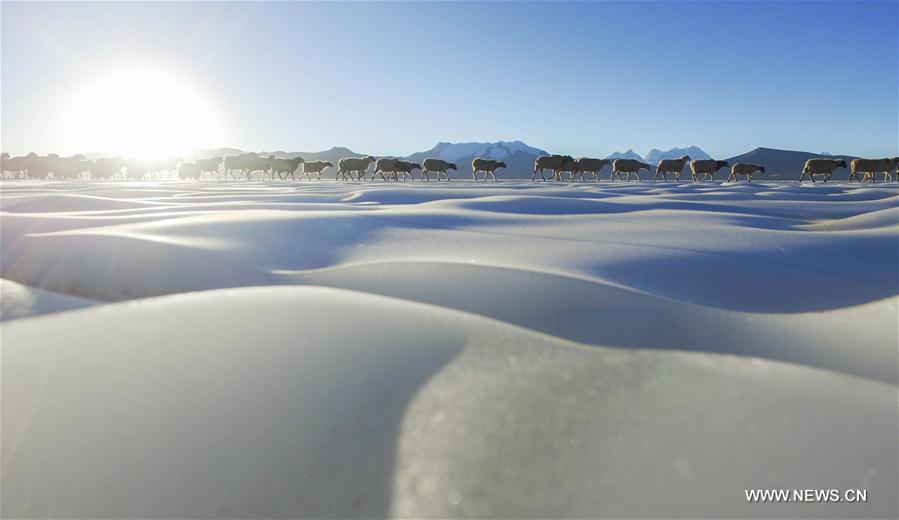
A herd of sheep move to an island on the frozen Puma Yumco Lake, southwest China's Tibet Autonomous Region, Feb. 9, 2017. It is the coldest point of the year in Tibet, and time for the annual migration of herds of sheep across an icy lake, a dangerous and exhilarating ancient practice. At Dowa village, 5,070 meters above sea level, thousands of sheep were taken across frozen water to two islands on Puma Yumco Lake, one of the world's highest lakes. The migration started before dawn. Hundreds of sheep move forward, one after another, and the icy surface squeaks under the enormous weight of the animals. When smaller animals wander off and fall, the herders take them back by carrying them in their arms. It takes more than two hours to complete the three-kilometer journey across the frozen lake. Herders will spend a month with the animals on the islands, where grass grows to waist height. [Xinhua/Purbu Zhaxi]